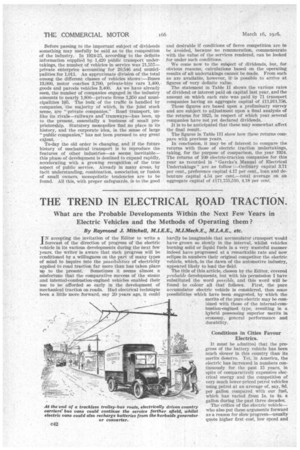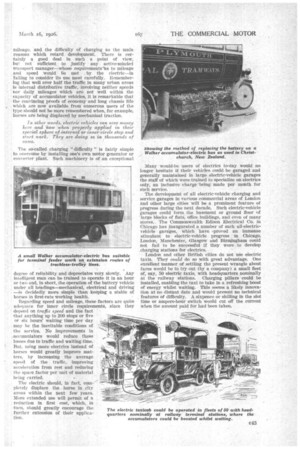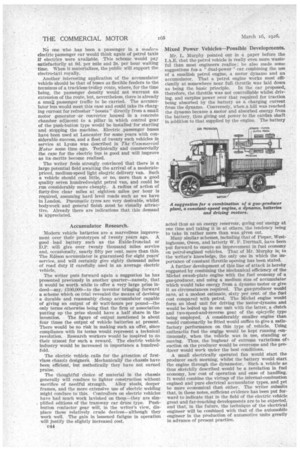THE TREND IN ELECTRICAL ROAD TRACTION.
Page 48

Page 49

Page 50

If you've noticed an error in this article please click here to report it so we can fix it.
What are the Probable Developments Within the Next Few Years in Electric Vehicles and the Methods of Operating them ?
By Raymond J. Mitchell, etc.
IN accepting the invitation of the Editor to write a forecast of the direction of progress of the electric vehicle in its various developments during the next few years, the writer is aware that such progress will he conditioned by a willingness on the part of many types of mind to inquire into the possibilities of electricity applied to road traction far more than has taken place up to the present. Sometimes it seems almost a misfortune that the comparative success of the steam and internal-combustion-engined vehicles enabled their use to be afforded so early in the development of mechanical traction on roads. Had electrical technique been a little more forward, say 20 years ago, it could
hardly be imaginable that accumulator transport would have grown so slowly in the interval, Whilst vehicles burning solid or liquid fuels in a very wasteful manner.. indeed have progressed at a remarkable rate and now, eclipse in numbers their original competitor the electric vehicle, which,.-in the dawn of the automotive industry, appeared likely to lead the field.
The title of this article, chosen by the Editor, covered probable developments, but with his permission I have substituted the word possible, and this word will be found to colour all that follows. First, the pure accumulator electric vehicle is considered, then some possibilities which have been suggested, by which the merits of the pure electric may be combined with those of the internal-combustion-engined type, resulting in a hybrid possessing superior merits in economy, general performance and durability.
Conditions in Cities Favour Electrics.
It must be admitted that the progress of the .battery vehicle has been much slower in this country than its merits deserve. Yet, in America, the electric, has increased in numbers continuously for, the past 15 years, in spite of comparatively expensive electrical energy and the competition of very much lower-priced petrol vehicles using petrol at an average of, say, 8d. per gallon compared with our fuel, which has varied from 1s. to 4s. a gallon during the past three decades.
The critics of the electric Vehicle— who also put these arguments forward as a reason for slow progress—usually quote higher first cost, low speed, and
mileage, and the difficulty of charging as the. main reasons which retard development. There is certainly a good deal in such a point Of view, but not sufficient to justify any . active-minded transport manager—whose requirements-4as to mileage and speed would 6e met by the electric—in failing to consider its use most carefully. Remembering that well over half the traffic in many urban areas 6 internal distributive traffic, involving neither speeds nor daily mileages which are not well within the capacity of accumulator vehicles, it is remarkable that the convincing proofs of economy and long chassis life which are now available from numerous. users of the type should not be more remembered when for example, horses are being displaced by mechanical traction.
In other words, electric vehicles can save money here and -now when properly applied in their special sphere of internal or inner circle stop and start work. They are doing so in thousands of eases.
The so-called. charging " difficulty " is fairly simple . to overcome by installing tine's own motor generator or converter plant. Such machinery is of an exceptional
degree of reliability and depreciates -very slowly. Any
intelligent man can be trained to operate it in an hour or two and, in short, the operation of the battery vehicle under all Ma.dings—inechanicai, electrical and driving —is decidedly more simple than keeping a stable of horses in first-rate working health.
Regarding speed and mileage, these factors are quite adequate for inner circle requirements, since they depend on traffic speed and the fact
that anything up to 200 stops or five or six hours' waiting time per day may be the inevitable conditions of the service. No improvements iii accumulators would reduce these losses due to traffic and waiting-time. But, using more electrics instead of horses would greatly improve matters, by increasing the average speed of the traffic, improving acceleration from rest and reducing the space factor per unit of material
being carried. • .
The electric should, in fact, completely displace the horse in city areas within the next few. years. More extended use will permit of a reduction in first cost, which, in turn, should greatly encourage the further extension of their application. Many would-be users of electrics to-day would no longer hesitate if their vehicles could be garaged and generally. maintained in large electric-vehicle garages the staff of which were trained to specialize on electrics only, an inclusive charge 'being made per month for such service.
The development of all electric-vehicle charging and service garages in various commercial areas of London and other large cities will be a prominent feature of progress during the next decade. Such electric-vehicle garages could form the basement or greund floor of large blocks of flats, office buildings, and even of many stores.The Commonwealth Edison Electrical Co. in Chicago has inaugurated a number of such all-electricvehicle garages, which 'have proved an immense stimulant to electric-vehicle progress in Chicago. London, Manchester, Glasgow and Birmingham could not fail to be successful if they were to develop ,charging stations for electrics.
London and other British cities do not use electric taxis. They could do so with great advantage. One excellent manner of settling the present wrangle about fares would be to try out (by a company) a small fleet of, say, 50 electric taxis, with -headquarters nominally at the railway stations. Charging pillars could be installed, enabling the taxi to take in a refreshing boost of energy whilSt waiting. This seems a likely innovation at no distant date and would present no technical , features of difficulty. A sixpence or shilling in the slot time or ampere-hour switch would cut off the current when the amount paid for had been taken.
No one who has been a passenger in a modern electric passenger car would think again of petrol taxis If electrics were available. This scheme would pay satisfactorily at 9d. per mile and 3s. per hour waiting time. When it materializes, the public will support the electro-taxi royally.
Another interesting application of the accumulator vehicle should be that of buses as flexible feeders to the terminus of a trackless-trolley route, where, for the time being, the passenger density would not warrant an extension of the route, but, nevertheless, there is already a small passenger traffic to be carried. The accumulator bus would meet this case and could take its charging current for refresher " boosts" directly from a small motor generator or converter housed in a concrete chamber adjacent to a pillar in which control gear of the push-button type would be installed for starting and stopping the machine. Electric .passenger buses have been used at Lancaster for some years with considerable success, and a fleet of• twenty such vehicles in service at Lyons was described in The Commercial Motor some time ago. Technically and commercially the case for the electric bus is good and will improve as its merits become realized.
The writer feels strongly convinced that there is a large potential field awaiting the arrival of a moderatepriced, medium-speed light electric delivery van. Such a vehicle should cost little, or no, more than a good quality seven hundredweight petrol van, and could be run considerably more cheaply. A radius of action of forty-five clear miles at eighteen miles per hour is required, assuming hard level roads such as we have in London. Pneumatic tyres are very desirable, whilst bodywork and general finish must be visually attractive. Already there are indications that this demand is appreciated.
Accumulator Research.
Modern vehicle batteries are a marvellous improvement over their prototypes of twenty years ago. A good lead battery such as tile Exide-Ironclad or D.P. will give over twenty thousand miles service and, occasionally, nearly fifty per cent, more than this. The Edison accumulator is guaranteed for eight years' service, and will certainly give eighty thousand miles of road duty if carefully used in an average electric vehicle, The writer puts forward again a suggestion he has presented previously in another quarter-.--namely, that it would be worth while to offer a very large prize indeed—say, £100,000—to the inventor bringing forward a scheme which on trial revealed the means of devising a durable and reasonably cheap accumulator capable of giving an output of 40 watt-hours per pound—the only terms otherwise being that the firm or association putting up the prize should have a half share in the invention. The figure of output mentioned is about four times the output of vehicle batteries at present. There would be no risk in making such an offer, since compliance with its terms would represent a technical revolution. Research workers would be inspired to do their utmost for such a reward. The electric vehicle Industry would be increased in importance a hundredfold.
The electric vehicle calls for the attention of first'class chassis designers. Mechanically the chassis have been efficient, but resthetically they have not earned praise.
The thoughtful choice of material in the chassis generally will conduce to lighter construction without
sacrifice of needful strength. Alloy steels, deeper frames, and the more extensive use of electric welding might conduce to this. Controllers on electric vehicles have had much work lavished on them—they are simplified editions of the tramway car drum type. Pushbutton contactor gear will, in the writer's view, displace these relatively crude devices— although they work well. The gain in lessened fatigue in operation will justify the slightly increased cost. Mixed Power Vehicles—Possible Developments.
Mr. L. Murphy pointed out in a paper before the I.A.E. that the petrol vehicle is really even more wasteful than most engineers realize ; he also made some suggestions fon a " dual-power" car combining the use of a smallish petrol engine, a motor dynamo and an accumulator. That a petrol engine works most efficiently at somewhere near full throttle was laid down as being the basic principle. In the car proposed, therefore, the throttle was not controllable whilst driving, and surplus power over that required for traction being absorbed by the battery as a charging current from the dynamo. Conversely, when a hill was reached the dynamo became a motor and absorbed energy from the battery, thus giving out power to the cardan shaft in addition to that supplied by the engine. The battery acted thus as an energy reservoir, giving out energy at one time and taking it in at others, the tendency being to take in rather more than was given out.
Many similar schemes, including that of Pieper, Westinghouse, Owen, and latterly W. P. Durtnall, have been put forward to ensure an improvement in fuel economy on petrol-engined vehicles. That of Mr. Murphy is, to the writer's knowledge, the only one in which the importance of constant throttle opening has been stated.
A further development of this line of attack is hereby suggested by combining the mechanical efficiency of the Michel swash-plate engine with the fuel economy of a gas-producer, and using a medium size of accumulator which would take energy from a dynamo motor or give it as circumstances required. The gas-producer would save, at a modest estimate, sixty per cent, of the fuel cost compared with petrol. The Michel engine would form an ideal unit for driving the motor-dynamo and would be belted up in one unit with the latter, a clutch and two-speed-and-reverse gear of the epicyclic type being employed. A considerably smaller engine than would customarily be fitted would suffice to give a satisfactory performance on this type of vehicle. Using anthracite fuel the engine would be kept running continuously, when the vehicle was in use, standing or moving. Thus, the bugbear of extreme variations of' suction on the producer would be overcome and the producer would work under the best conditions.
A small electrically operated fan would start the producer each morning, whilst the battery would start the engine through the dynamotor. Such a vehicle as thus sketchily described would be a revelation in fuel economy, low cost of operation and ease of handling. It would combine the virtue,s of the internal-combustion engined and pure electrical accumulator types, and yet be more economical than either. The writer submits that, in these notes, sufficient evidence has been put forward to indicate that in the field of the electric vehicle great and far-reaching developments are to be expected, and that, in the future, the technique of the electrical engineer will be combined with that of the automobile engineer in the production of automotive units greatly in advance of present practice.


























































